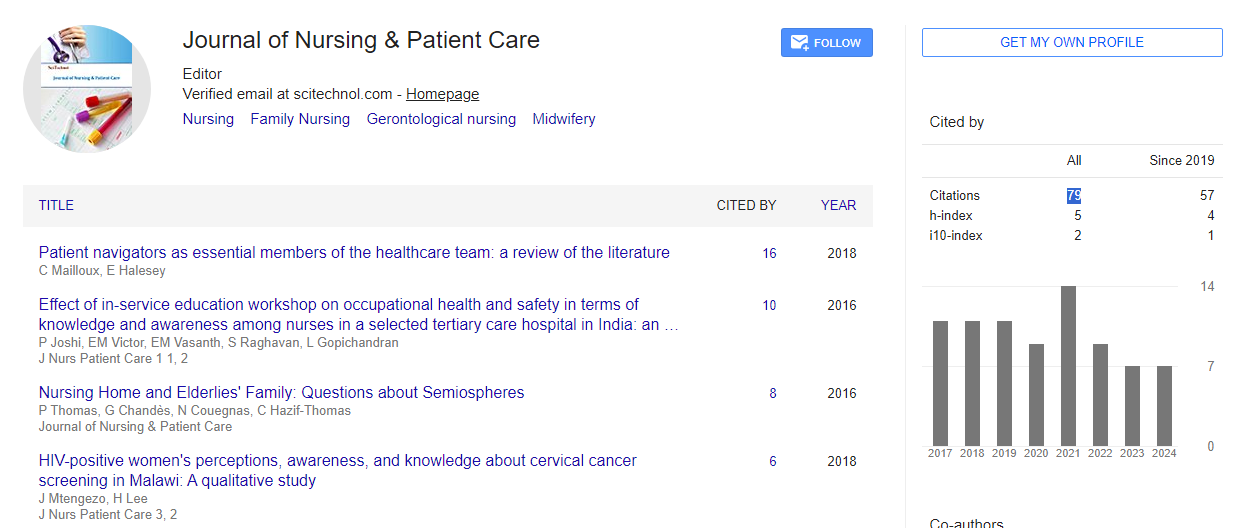Perspective, J Nurs Patient Care Vol: 9 Issue: 2
Regulatory Changes in Oncology Care
Lemmon Sibel*
1Department of Pediatric Nursing, Pamukkale University, Pamukkale, Turkey
*Corresponding Author: Lemmon Sibel,
Department of Pediatric Nursing,
Pamukkale University, Pamukkale, Turkey
E-mail: lemmonsib@el.tr
Received date: 28 May, 2024, Manuscript No. JNPC-24-140259;
Editor assigned date: 30 May, 2024, PreQC No. JNPC-24-140259 (PQ);
Reviewed date: 13 June, 2024, QC No. JNPC-24-140259;
Revised date: 21 June, 2024, Manuscript No. JNPC-24-140259 (R);
Published date: 28 June, 2024, DOI: 10.4172/2573-4571.1000060.
Citation: Sibel L (2024) Regulatory Changes in Oncology Care. J Nurs Patient Care 9:2.
Description
Oncology care, the specialized field focused on the prevention, diagnosis, and treatment of cancer, is heavily influenced by regulatory changes that shape standards of care, access to treatments, and patient outcomes. These changes stem from evolving research, technological advancements, and efforts to improve safety, efficacy, and equity in cancer treatment. The regulatory landscape in oncology care is dynamic, driven by the need to ensure patient safety, promote innovation, and address emerging challenges in cancer treatment. Regulatory bodies, such as the Food and Drug Administration (FDA) in the United States and the European Medicines Agency (EMA) in Europe, play a central role in evaluating and approving new cancer therapies, devices, and diagnostic tests.
Recognizing the urgency of treating life-threatening diseases like cancer, regulatory agencies have implemented accelerated approval pathways. These pathways allow for expedited review and approval of promising therapies based on preliminary evidence of clinical benefit, such as tumor shrinkage or improved survival rates in early-stage trials. Accelerated approvals enable quicker access to potentially lifesaving treatments for patients with limited therapeutic options. However, the use of accelerated approval pathways necessitates postmarketing studies to confirm the clinical benefits observed in early trials. This approach balances the need for timely access to innovative therapies with the requirement for comprehensive safety and efficacy data.
Advancements in molecular biology and genomics have revolutionized cancer treatment through precision medicine approaches. Regulatory changes support the development and use of biomarker-driven therapies that target specific genetic mutations or molecular characteristics of tumors. Biomarker testing, such as Next- Generation Sequencing (NGS) and companion diagnostics, plays a important role in identifying patients who are likely to benefit from targeted therapies, thereby optimizing treatment outcomes and minimizing unnecessary side effects. Regulatory agencies work to streamline the approval process for biomarker tests and ensure their accuracy and clinical utility. This includes establishing standards for test validation, proficiency testing, and quality assurance to facilitate widespread adoption and integration into clinical practice.
Expanded access programs, also known as compassionate use programs, provide patients with access to investigational therapies outside of clinical trials when no satisfactory treatment alternatives are available. Regulatory changes have facilitated the expansion and accessibility of these programs, allowing more patients to potentially benefit from promising treatments that are still under investigation.
These programs involve collaboration among regulatory agencies, healthcare providers, pharmaceutical companies, and patients to ensure ethical oversight, informed consent, and careful monitoring of treatment outcomes. Expanded access programs contribute to patientcentered care by offering hope and potential therapeutic options to individuals facing advanced or refractory cancers.
Health technology assessments evaluate the clinical efficacy, costeffectiveness, and broader societal impacts of new cancer treatments and technologies. Regulatory agencies increasingly rely on HTAs to inform reimbursement decisions and coverage policies, ensuring that healthcare resources are allocated efficiently and equitably. HTAs consider factors such as comparative effectiveness, patient-reported outcomes, and economic modeling to assess the value of new therapies in real-world clinical settings. These assessments influence pricing negotiations between healthcare payers, pharmaceutical manufacturers, and government agencies, ultimately shaping access to innovative oncology treatments.
Regulatory changes have expanded access to innovative cancer therapies by accelerating approval timelines and facilitating the development of targeted treatments. Patients benefit from earlier access to therapies that offer improved efficacy, reduced toxicity, and personalized treatment approaches based on biomarker testing. Stringent regulatory standards ensure that cancer treatments meet rigorous criteria for safety, efficacy, and manufacturing quality. Healthcare providers adhere to established guidelines and protocols to minimize treatment-related risks and optimize patient safety throughout the care continuum.
Conclusion
Looking ahead, future regulatory efforts will focus on enhancing regulatory efficiency, fostering collaboration across international borders, and leveraging real-world evidence to inform decisionmaking. By balancing innovation with patient safety and healthcare equity, regulatory changes will continue to shape the landscape of oncology care, driving progress toward improved cancer outcomes and enhanced quality of life for patients worldwide.
 Spanish
Spanish  Chinese
Chinese  Russian
Russian  German
German  French
French  Japanese
Japanese  Portuguese
Portuguese  Hindi
Hindi 